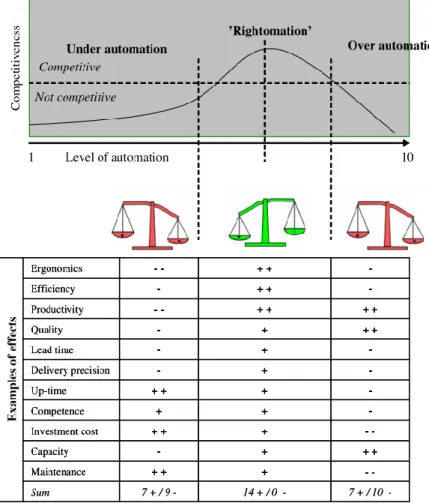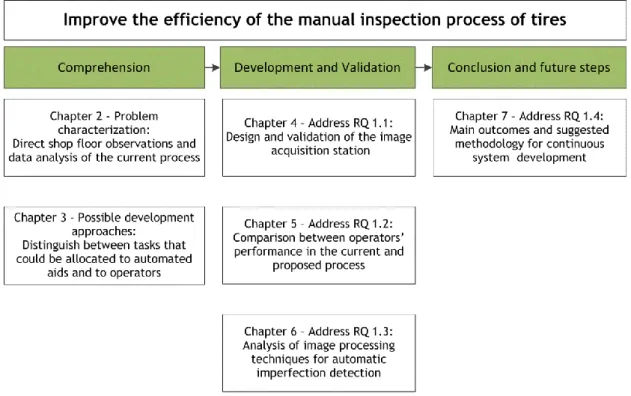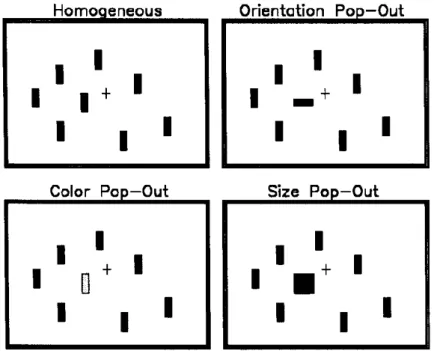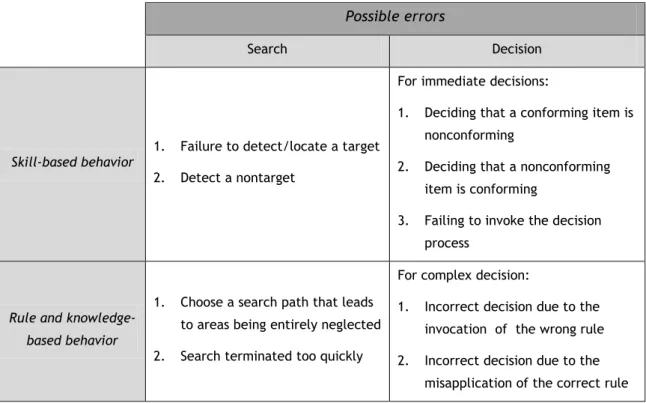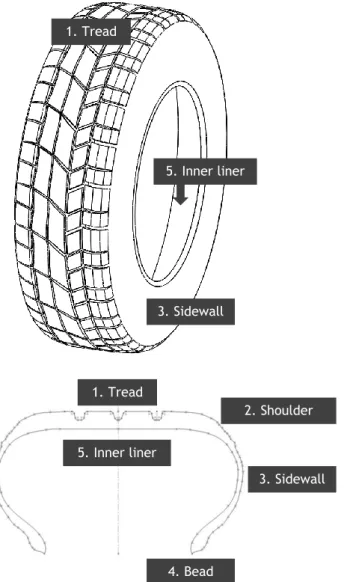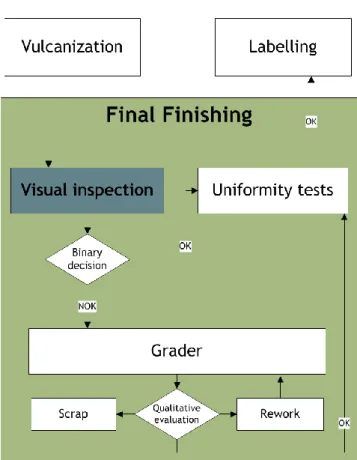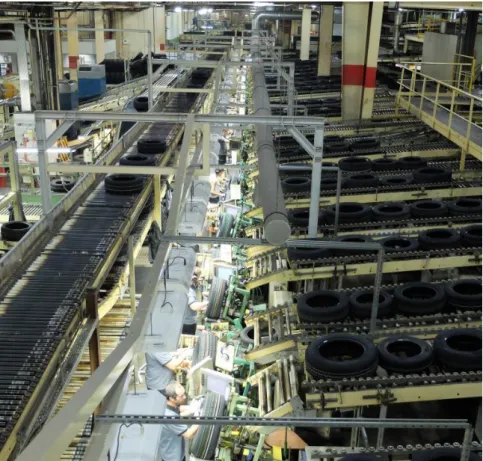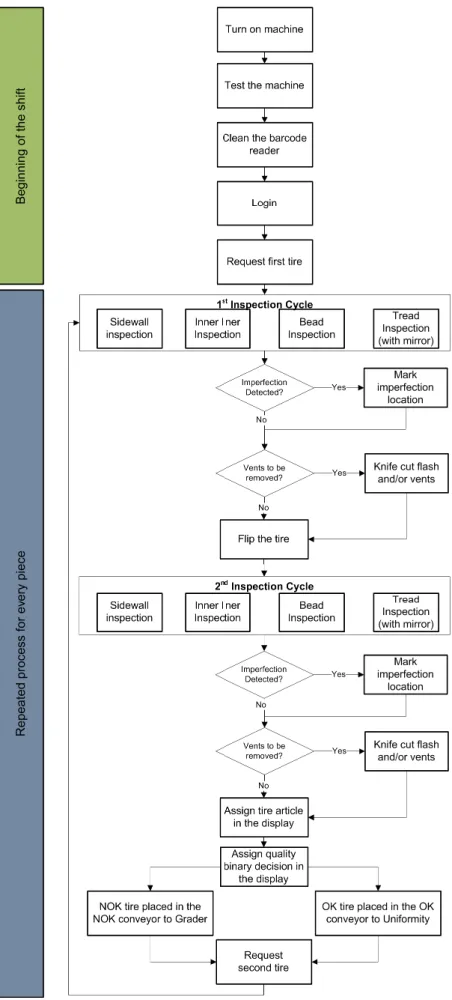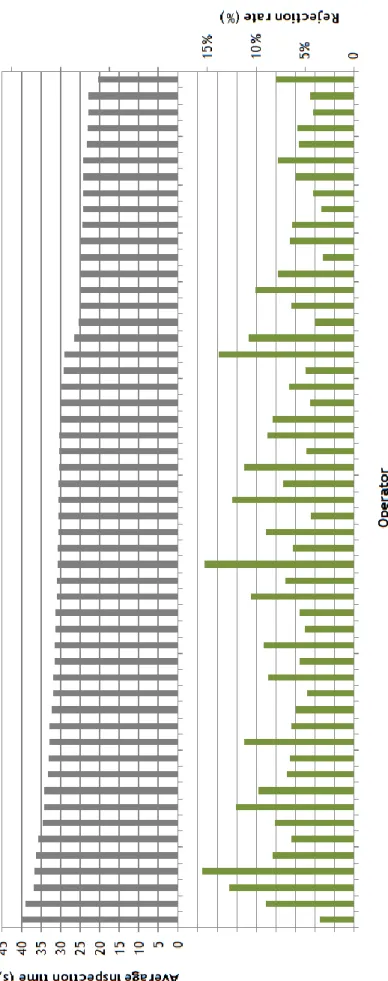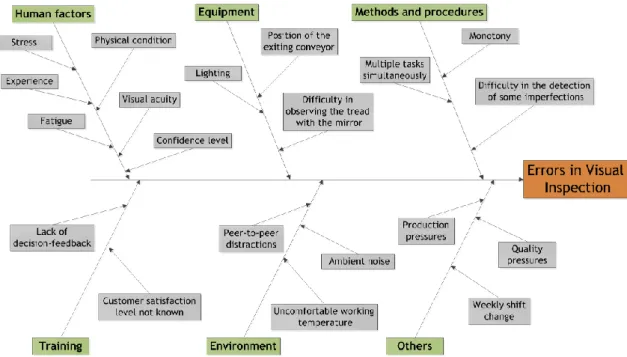CONTROL SYSTEM
STEPS TOWARDS AUTOMATIC MACHINE VISION INSPECTION
ANA EDUARDA DE SÁ SILVA
TESE DE DOUTORAMENTO APRESENTADA
À FACULDADE DE ENGENHARIA DA UNIVERSIDADE DO PORTO
UNIVERSIDADE DO PORTO A N A ED U AR D A D E SÁ SI LV A
D
2014
FEUP 2014 ST EP S T O W AR D S A U TO M ATI C M A CHIN E VISIO N INSP EC TIO NCollaborative human-machine quality
control system: steps towards automatic
machine vision inspection
Ana Eduarda de Sá Silva
January 2014
A dissertation submitted to the Faculty of Engineering of the University of Porto
for the degree of Doctor of Philosophy in Leaders for Technical Industries
iii
Supervisor
Prof. Dr. Paulo José Cerqueira Gomes da Costa
Faculty of Engineering of the University of Porto
Co-Supervisor
Prof. Dr. António Fernando Ribeiro
University of Minho
v
Abstract
This thesis explores ways of increasing the efficiency of an industrial process by resorting to automated machine vision technologies. The research focuses on the quality inspection process in the tire industry.
The general trend found in the literature to improve the efficiency of quality inspection processes is to introduce machine vision systems to replace humans in the visual search and conformity decision tasks. The original contribution of this study is showing that operators should be integrated in the development process and perform continuous validation of each technological sub-component. In such an ambiguous and complex task as quality inspection process of tires, operators’ expertise and knowledge needs to be acquired to assure that the technological solutions being proposed sustain the same quality standards. Thus, the machine vision solutions developed during this research project do not aim at replacing the operators, but rather at maximizing the advantages they bring to the inspection system through a Computer Assisted Inspection (CAI). This will continue up to a moment in which technology reliability is demonstrated as adequate and the automated solutions can be deployed as a stand-alone inspection method.
The thesis is based on qualitative and quantitative research undertaken over three years in collaboration with Continental Mabor SA. Initial chapters explore the current inspection methods used by specialized operators. Later chapters describe the underlying concepts and the re-design process of the inspection system. This proposed process follows a framework that considers scenarios of different levels of automation. A prototype suitable for industrial environment was developed and made possible proving the validity of the proposed solution. Each sub-component of the system was tested and validated through systematic experimentation. Special focus was given to the image-acquisition station, as the appropriateness of the images influences both human-based and automatic subsequent quality assessments.
In the chapters focused on the results it is shown that combining operators’ knowledge, machine vision technologies and automatic detection algorithms contribute to an increase in process efficiency (higher throughput) and effectiveness (increase the number of correct decisions). The baseline strategy for automatic imperfection detection based on a self-adaptive and deformable template match (SAD-TM) technique is proposed in this dissertation and validated for a number of cases. Future work should focus on the continuous development of automatic detection algorithms, enlarging number of imperfections tested and refining its detection capabilities.
vi
The main outcome of this thesis is the development on the understanding of the potential benefits of introducing machine vision technologies in the quality inspection process of tires. The proposed strategy of complementing human and automation towards the development of more efficient processes is expected to be applicable in other environments besides the tire industry.
Regarding the outcomes that are relevant to the industrial partner, the performed research suggests that the industrial implementation of the proposed system is viable and should occur iteratively, attempting to a continuous increase of level of automation.
vii
Resumo
A tese apresentada explora formas de aumentar a eficiência de um processo industrial recorrendo a visão por computador. A investigação centra-se no processo de controlo de qualidade na indústria de pneus.
A tendência dominante encontrada na literatura, no que toca à melhoria da eficiência do controlo da qualidade, consiste na introdução de sistemas de visão por computador em substituição de operadores. A contribuição mais inovadora deste estudo é demonstrar que os operadores devem ser integrados no processo de desenvolvimento e que os subcomponentes tecnológicos devem ser sempre validados juntos destes. No caso de uma tarefa tão ambígua e complexa como a inspecção de qualidade de pneus, as suas competências e conhecimentos devem ser captados de forma a assegurar que a solução tecnológica apresentada é capaz de garantir os mesmos níveis de qualidade. Desta forma, as soluções que envolvem visão por computador e que foram desenvolvidas durante este projecto de investigação não tencionam substituir os operadores, mas antes maximizar as vantagens que estes trazem às tarefas de inspecção num meio assistido informaticamente. Esta situação deverá manter-se até que a tecnologia demonstre uma fiabilidade adequada e as soluções automatizadas possam ser implementadas com um método de inspecção autónomo.
A tese baseia-se em investigação qualitativa e quantitativa que decorreu ao longo de três anos em colaboração com a Continental Mabor SA. Os capítulos iniciais exploram os métodos de inspecção actuais utilizados por operadores especializados. Os capítulos conseguintes descrevem os conceitos subjacentes a um sistema de inspecção e o seu processo de desenvolvimento. Ao longo deste processo são ponderados cenários com diferentes níveis de automação. Cada subcomponente do sistema foi testado e validado através de experimentação sistemática. Especial destaque foi dado ao sistema de aquisição de imagens, dado que a adequação das imagens influencia tanto a inspecção feita pelos operadores, como as avaliações automáticas subsequentes.
Nos capítulos focados em resultados mostra-se que a combinação de conhecimentos detidos pelos operadores, visão por computador e algoritmos de detecção contribuem para uma maior eficiência do processo (throughput mais elevado) e efectividade (maior número de decisões correctas). A estratégia para a automação da detecção automática de imperfeições baseada numa técnica de template match auto-adaptativa e deformável é proposta nesta dissertação e validada para um conjunto de casos. O trabalho futuro deverá incidir principalmente no desenvolvimento continuado de algoritmos de detecção automática, aumentando o número de imperfeições testadas e refinando as suas capacidades de detecção.
viii
O principal resultado desta tese é o desenvolvimento no sentido de compreender os potenciais benefícios da introdução de tecnologias de visão por computador na inspecção de qualidade de pneus. A estratégia proposta de complementar reciprocamente os contributos trazidos pela automação e pelos operadores com vista a um processo mais eficiente tem perspectivas de aplicabilidade em outras indústrias para além da indústria de pneus.
Ao parceiro industrial, esta investigação sugere que a implementação do sistema proposto à escala industrial é viável e deve ocorrer iterativamente, com vista a um aumento contínuo do nível de automação.
ix
Acknowledgements
The research described in this document was potentiated by the cohesion of a team that along three years formed AutoClass project. Commitment and knowledge sharing across the various organizations were essential for the undermentioned accomplishments. Being part of a team involving: Faculty of Engineering of the University of Porto, INESC Porto, University of Minho, Instituto Superior Técnico, MIT and Continental Mabor SA; was an extraordinary experience that positively enriched my professional and personal lives. I am really thankful to the MIT-Portugal Program for facilitating and supporting the initiative on the basis of this project.
Individual acknowledgements can only start by thanking my supervisor, Prof. Paulo Costa from the Department of Electrical and Computer Engineering of the Faculty of Engineering of the University of Porto. Prof. Paulo Costa’s extensive and solid knowledge, guidance, support, availability and sympathy were essential to the orientation of this research and to my motivation and confidence. As co-supervisor, Prof. Fernando Ribeiro from University of Minho was an important element who raised pertinent questions along the research process and permanently demonstrated care for my interests. For having demonstrated an involvement level comparable to a supervisor, I would like to thank Dr. Rui Bonifácio from Continental Mabor SA. He was a solid presence in the development of this research. Our fruitful discussions and sometimes difference perspectives made this doctoral process much more interesting and enlarged my responsibility and focus.
Still in my closer work sphere, I would like to thank my doctoral colleagues Michael Donauer and Jorge Ribeiro. Due to a higher interconnection with my work, Jorge Ribeiro was my daily colleague and friend in the past three years. And I am sure he will continue to be so for many years to come. I also take this chance to thank to his supervisors (Prof. António Paulo Moreira and Prof. Gil Lopes) who always provided attention and advices as direct supervisors would do.
João Paulo Silva, Paulo Malheiros and Bruno Pereira as technical engineers in this project were much more than enablers of technical implementation. They were developers, testers, researchers, managers, innovators, and friends indeed. Thank you.
The emergence of this project was possible due to the MIT-Portugal Program, especially EDAM (Engineering Design and Advanced Manufacturing) focus area. I would like to thank Prof. António Torres Marques, Prof. Pedro Camanho, Prof. Francisco Pires and more directly Prof. Jean Pol Piquard for promoting this project and integrate doctoral students in such an intense and challenging research project. Also thank you for allowing that this period of doctoral studies was shared with interesting, dedicated, professional and enjoyable
x
colleagues, with whom I shared achievements, frustrations, stressful and relaxed situations that were the foundations of solid friendships: Anton Sabaleuski, Filipe Nascimento, Jorge Ribeiro, Pedro Duarte, Ricardo Sá and Rui Rocha.
I would like to thank Carla Monteiro, Helena Leal and, more recently, Flávia Ferreira in the role of Execute Assistants. Their timely and informative answers helped keeping every aspect of this project on track.
The acknowledgments in the context of Portuguese Higher Educational Institutions cannot finish without thanking INESC Porto, through Dr. Augustin Olivier and Eng. Carlos Pinho at a project management level and the Robis Unit and its researchers and technicians for the support in the technological development. The role and involvement of Dr. Germano Veiga in this context should be mentioned and acknowledged.
Massachusetts Institute of Technology (MIT) was a present institution across my doctoral studies. I would like to thank MIT initially for giving me the opportunity to participate in curricular units lectured by interesting and remarkable individuals, whom I was given the chance to interact with. More recently thank you for my research period at MIT which significantly contributed to a higher level of professional enrichment. Regarding this, I would like to special thank Prof. Jeremy Gregory, Prof. Qi Hommes and Prof. Lisa D'Ambrosio.
Continental Mabor SA dedication and commitment with this project was essential. The dependency in Continental Mabor SA to access data, information, and perform field studies was never a limitation but rather the most interesting component of this research, for which I am truly grateful. The mutual interests facilitated this institutional involvement but Continental Mabor collaborators made it possible and pleasant. Across all the structure of the organization, the availability and interest was constant. Thank you Eng. António Lopes Seabra, Eng. José Carvalho Neto and more recently Eng. Pedro Carreira, whom, while plant managers, always stressed the relevance of this project. Thank you José Gouveia, Rodrigo Antunes and Ana Duarte for helping and many times being valid and constructive research critics. At a more operational level I would like to thank Production, Quality, and Engineering Departments at Continental Mabor, emphasizing the interest and availability demonstrated by visual inspectors, graders, supervisors, among others.
I would like to thank Fundação para a Ciência e a Tecnologia through 3º Quadro Comunitário de Apoio, and the POCTI ande FEDER programmes. I also gratefully acknowledge the funding source for my scholarship that made my PhD work possible, Fundação para a Ciência e a Tecnologia of the Portuguese Government, through PhD scholarship SFRH/BD/33905/2009.
My previous research experiences significantly contributed to the accomplishments obtained along this doctoral research. Aspects such as critical mindset and knowledge-inquiry spirit, started to be cultivated before this project and for that I should thank my two MSc supervisors that are still today, mentors and friends: Prof. Nathan Quinlan from National University of Ireland, Galway and Prof. Senhorinha Teixeira from University of Minho.
Going through the complex and overwhelming experience of a PhD was only possible because I have a whole structure of friends and family that contribute to my peaceful, stable and optimistic way of being. Because of the extension of the list of people and the risk of
xi forgetting someone, I will not mention them individually. I am sure each one of them is aware of his/her importance on this.
Not only acquiring knowledge filled my past 4 years. Acquiring a husband and a whole new family branch has been marvelous. Thank you all. Finally thank you to my parents and sister for the usual presence and comfort provided.
xiii
Contents
List of Figures ... xv
List of Tables ...xxi
List of Acronyms ... xxiii
List of Symbols ... xxv
Chapter 1 - Introduction ... 1
The nature of manual visual inspection ... 1
1.1 Automated and hybrid manufacturing systems ... 3
1.2 Research gap and research questions ... 6
1.3 Research institutions and industrial partner ... 11
1.4 Dissertation Synopsis ... 12 1.5 References ... 13 1.6
... 17
Chapter 2 - Methods for manual inspection processes
2.1 The nature of manual visual inspection ... 172.2 Human errors ... 23
2.3 Manual inspection in the tire industry context ... 26
2.3.1Tire fundamentals ... 26
2.3.2Tire manufacturing process ... 28
2.3.3Visual Inspection procedure and criteria ... 32
2.4 Variability, heuristics and deviations in tire manual inspection ... 38
2.5 References ... 46
Chapter 3 - Redesigning the manual inspection process of tires ... 49
3.1 Models for designing hybrid systems ... 49
3.2 Tire inspection functions that may be automated ... 53
3.3 Proposed system design ... 58
xiv
Chapter 4 - Machine vision system for imaging acquisition of tires ... 63
Overview of industrial machine vision applications ... 64
4.1 Proposed architecture for image acquisition system ... 68
4.2 Mechanical system ... 68
4.2.1 Machine vision system ... 71
4.2.2 Validation of image acquisition system... 88
4.3 References ... 95
4.4
Chapter 5 - Experimental design for computer assisted inspection validation ... 99
Computer assisted inspection: Design and validation ... 100
5.1 Experimental Design ... 101 5.2 Results ... 103 5.3 References ... 107 5.4
Chapter 6 - Methods for automatic quality assessment of tires ... 109
Image processing techniques for quality assessment ... 110
6.1 Proposed algorithms ... 114
6.2 Tire identification ... 114
6.2.1 Strategies for automatic quality inspection ... 117
6.2.2 6.2.2.1 Comparison run setup ... 120
6.2.2.2 Self-adaptive and deformable template matching algorithm (SAD-TM) ... 121
6.2.2.3 Comparison and classification ... 125
Results ... 127
6.3 References ... 133
6.4
Chapter 7 - Conclusions ... 137
7.1 Recommendations for continuous development ... 139
xv
List of Figures
Figure 1.1 - Appropriate level of automation, ‘rigthomation’, and positive and negative
effects of ‘under automation’ and ‘over automation’ (Säfsten, Winroth and Stahre 2007). ... 5 Figure 1.2 – Main research question and subsequent division in sub-questions. ... 9
Figure 1.3 – Methods used to answer each sub-research question. ... 10
Figure 1.4 – Research topics and their correlation with research questions for a novel
inspection system development. ... 12 Figure 2.1 - The Skill, Rule, and Knowledge-Based Model (Rasmussen 1983; Marmaras and
Kontogiannis 2001). ... 20 Figure 2.2 – Examples of the homogeneous, orientation pop-out, color pop-out and size
pop-out stimulus array (Luck and Hillyard 1994). ... 22 Figure 2.3 – Example to illustrate why some search tasks are easier than others. Finding
the target blue–yellow–red ‘molecule’ is trivial in (a) because of the unique red element. Search is much less efficient in (b) because no unique feature defines the target (Wolfe 2003). ... 22 Figure 2.4 - Stages in the development of an organisational error (Reason 2005). ... 25 Figure 2.5 – Illustration of the tire carcass composed by several parts: tread (1), shoulder
(2), sidewall (3), bead (4), and inner liner (5). ... 26 Figure 2.6 – Description of tire codes embossed on tire sidewall (a) Dimensional
information, (b) Mold number and DOT. ... 27 Figure 2.7 – Generic tire manufacturing process. ... 29 Figure 2.8 – Diagram illustrating the process flow in the Final Finishing area. ... 29 Figure 2.9 - Diagram with the layout of the Visual Inspection process within the industrial
partner. ... 30 Figure 2.10 – Overview of the visual Inspection process at Continental Mabor. ... 31 Figure 2.11 – Example of a VI workplace at Continental Mabor. ... 32 Figure 2.12 – Visual and Haptic Search in the tire quality inspection process. On the left a
detail of a simultaneous downward sidewall observation and trimming is shown while on the right the operator is inspecting the inner liner both visually and
haptically. ... 33 Figure 2.13 – Standard procedure to perform tire quality inspection at Continental Mabor. .. 34 Figure 2.14 – Examples of imperfections in tires. From left to right a blemish in the
sidewall, a blister in the inner liner and a blemish in the tread are shown. ... 35 Figure 2.15 – Distribution of imperfection codes for a period of six months. ... 36
xvi
Figure 2.16 – Histogram of the distribution of NC occurrence across tire areas. ... 36 Figure 2.17 - Time allocation to the several tasks included in the inspection process. ... 38 Figure 2.18 – Distribution of inspection times of five-day production volume. ... 39 Figure 2.19 – Average inspection time and average rejection rate plotted individually to
53 operators. Average data calculated for a period of one month. ... 40 Figure 2.20 – Percentage of errors in which the operator missed the detection of an
imperfection across the tire areas. ... 45 Figure 2.21 – Cause and effect diagram for errors in the visual inspection of tires. ... 45 Figure 3.1 – Examples of systems with different levels of automation across the four
classes of functions: information acquisition, information analysis, decision and action selection, and action implementation (adapted from Parasuraman, Sheridan and Wickens (2000)). ... 52 Figure 3.2 – Possible types and levels of automation for future inspection process of tires... 57 Figure 3.3 – Diagram illustrating the proposed process flow in the Final Finishing area ... 59 Figure 4.1 – Information chain and knowledge domains in an machine vision system
(adapted from Hornberg (2006)). ... 63 Figure 4.2 - Decomposition of the proposed inspection process of tires. ... 64 Figure 4.3 – Components of an industrial machine vision system (adapted from Al-Mallahi
et al. (2010)). ... 65 Figure 4.4 – Drawings of the mechanical system for image acquisition: (a) overall view;
(b) tire placement; (c) detail of the rolling axes (d) robot in which the vision system for inner liner inspection is coupled. ... 69 Figure 4.5 – Prototype installed at the manufacturing plant ... 70 Figure 4.6 – Block diagram describing setup and acquisition ... 70 Figure 4.7 – Representation of the sidewall sequential image acquisition: a) the angular
speed of the rolling axes is transmitted to the tire. The linear speed is not uniform along the sidewall height or the tire radius. b) The image is formed by
concatenating successive frames. Repetition of information is unavoidable. c) The time diagram shows that each frame is captured at a regular defined external
trigger rate. ... 72 Figure 4.8 - Elongation of the image close to tire inner diameter: (a) in yellow the real
circle, (b) in red the elongated circle ... 72 Figure 4.9 - Frame rate vs. height for Prosilica GC780 ... 74 Figure 4.10 – Light reflection in sharp edge (a), rounded object (b) and rough surface (c)
(adapted from Hornberg (2006)). ... 76 Figure 4.11 – Sections of inner liner images of the same tire article presenting: on the left
a non-painted tire and on the right a painted tire. ... 76 Figure 4.12 – Interaction between test object, light and camera: bright field setup on the
xvii
Figure 4.13 – Non-uniform reflectance of the tire curved sidewall ... 78
Figure 4.14 – Illustration demonstrating the two light sources and the need for its reposition. The smaller tire on the left requires a height (h1) while the bigger tire on the right requires h2 between the two light sources to assure the illumination of the entire sidewall. ... 79
Figure 4.15 – Example of an articulated arm for lighting support. ... 79
Figure 4.16 – Illustration of the sidewall image acquisition setup: two articulated arms for light positioning and one camera (in red). ... 81
Figure 4.17 – Pictures of the prototype: in the top image the articulated arms are in the home position, while in the bottom image an acquisition is taking place. ... 81
Figure 4.18 - Example of user interface environment when defining a lighting configuration. The window being captured is shown in red. On top of each image the intensity profile is plotted. In the left image only the bottom LED array is emitting light and on the right, only the top LED array is on. ... 82
Figure 4.19 – Lighting configuration for a conforming tire. On left the inside sidewall and on the right the outside sidewall of the same tire are shown. ... 83
Figure 4.20 – Illustrations and picture of the tread image acquisition setup. The lighting system can be seen in the top images colored in yellow and blue while the camera is illustrated in red on the right. The bottom image aims to better show the prototype context. ... 84
Figure 4.21 – Schematic representation of the vision system for the tread and sidewall acquisition. ... 84
Figure 4.22 - Schematic representation of the vision system for the inner liner acquisition. ... 85
Figure 4.23 - Illustrations and picture of the inner liner image acquisition setup. ... 86
Figure 4.24 – Example of a sidewall imperfection, manually delimited with an orange elliptic shape. Brighter intensities are visible in the imperfection region. ... 86
Figure 4.25 - Example of a tread imperfection, manually delimited with an orange elliptic shape. Darker intensities are visible in the imperfection region. ... 87
Figure 4.26 - Example of an inner liner imperfection, manually delimited with an orange elliptic shape. Variations from brighter to darker intensities are visible in the imperfection region. ... 87
Figure 4.27 – Research question and respective methods used for its test... 88
Figure 4.28 – Photographic depiction of the workplace proposed for CAI. ... 89
Figure 4.29 – CAI user interface and imperfection mark... 90
Figure 4.30 - Validation process defined to continuously improve tire images. ... 91
Figure 4.31 – For each NC in the sidewall the plot shows: the number of successful and unsuccessful validation cases and its frequency of occurrence in the past 6 months. ... 92
Figure 4.32 - For each NC in the tread the plot shows: the number of successful and unsuccessful validation cases and its frequency of occurrence in the past 6 months. ... 93
xviii
Figure 4.33 - For each NC in the inner liner the plot shows: the number of successful and
unsuccessful validation cases and its frequency of occurrence in the past 6 months. ... 93
Figure 4.34 – Schematic of the final setup of cameras. The sidewall cameras also cover the acquisition of the bead area (1) but difficulties in adequately acquiring the bead edge (2) were noticed. ... 94
Figure 5.1 – Operationalization of the experiment. ... 102
Figure 5.2 – Performance comparison between control group, experimental group and assisted experimental group. ... 104
Figure 5.3 – Relation between area shown to operators and performance indicators (quality detection and inspection time). ... 104
Figure 5.4 – Performance of the several inspection methods: Manual, CAI, Assisted CAI. .... 106
Figure 6.1 - The Checker Shadow Illusion: On the right, proof that square A and B have identical intensities (Adelson 2000). ... 111
Figure 6.2 – Examples of textured materials. The images show: on the left an uniform textile pattern and on the right a random pattern in a solar wafer ((Nixon and Aguado 2012a; Tsai, Chang and Chao 2010). ... 111
Figure 6.3 – Result obtained by using direct-TM. ... 115
Figure 6.4 – Overall view of the two images to be compared. ... 115
Figure 6.5 - Steps followed for color line calibration and subsequent identification. ... 116
Figure 6.6 –Two images exemplifying the color lines being accurately identified. Color identification output on top and acquired images on bottom. ... 116
Figure 6.7 – Conventional sequence of steps in automated inspection through template matching (adapted from Crispin and Rankov (2009))... 118
Figure 6.8 – Sample image shown on top and the resulting differences and their classification are shown on the bottom... 119
Figure 6.9 – Proposed sequence of steps for automatic imperfection detection in tires. ... 119
Figure 6.10 – Parameters needed to define a comparison run. ... 121
Figure 6.11 – Block diagram of the proposed algorithm. ... 122
Figure 6.12 – Misalignment of blurred squares between template and sample image. ... 123
Figure 6.13 – Comparison between differences obtained before and after corrections. ... 123
Figure 6.14 – Discontinuities visible between sub-images in the reconstructed sample image. ... 124
Figure 6.15 – Bilinear interpolation method used to minimize discontinuities. ... 124
Figure 6.16 – Reconstruction of the case in Figure 6.14 after the implementation of the bilinear interpolations. ... 125
xix
Figure 6.18 – Detection of a blister in the inner liner. ... 127 Figure 6.19 – Blobs detected for the comparison run illustrated in Figure 6.18 for three
different testing scenarios and methods applied. ... 128 Figure 6.20 – Detection of a cut in the tread. ... 129 Figure 6.21 – Detection of a blemish in the sidewall. ... 130 Figure 6.22 – Relation between Window Search dimensions (WSW and WSH) and the total
differences obtained for each case. ... 130 Figure 6.23 – Detection of flash in the sidewall. ... 132 Figure 7.1 – Proposed methodology for continuous system development. ... 141
xxi
List of Tables
Table 2.1 – Possible outcomes of inspection (adapted from Drury (2001)). ... 23 Table 2.2 – Analysis of generic errors associated to Search and Decision in the scope of
SRK model. ... 24 Table 2.3 – Generic errors in the manual inspection of tires and list of probable causes. ... 43 Table 3.1 - Ten-level scale of levels of automation (adapted from Sheridan (1995)). ... 50 Table 3.2 – The Fitts list (adapted from Fitts (1951)). ... 51 Table 3.3 – Main tasks in the manual inspection process of tires ... 54 Table 4.1 - List of industrial vision applications. ... 67 Table 4.2 – Configurations of the articulated arm according to the tire area ... 80 Table 4.3 – Image attributes computed to define a lighting configuration ... 82 Table 6.1 – Results obtained in the quality assessment of images from the inner liner,
xxiii
List of Acronyms
2D Two-dimensional
3D Three-dimensional
CAD Computer-Aided Design
CAI Computer Assisted Inspection
CCD Charge-coupled device
DOT Department of Transportation
FOV Field of View
fps Frames per second
HSL Hue, Saturation, and Lightness color model
LED Light-emitting diode
LOA Level of Automation
NC Non-conformity
NOK Not Okay
OpenCV Open Source Computer Vision Library OpenGL Open Graphics Library
PCB Printed Circuit Board
PWM Pulse-width Modulation
px Pixel
RGB Red, Green, and Blue color model
SAD-TM Self-Adaptive and Deformable Template Match
SKR Skill-Rule-Knowledge
TM Template Matching
WSH Window Search Height
WSR Window Search Radius
xxv
List of Symbols
Angular speed
Camera vertical resolution Focal length
Gain Illuminance Intensity Linear speed Magnification Spatial resolution
xxvii
There's nothing you can know that isn't known. Nothing you can see that isn't shown. Nowhere you can be that isn't where you're meant to be. Lennon–McCartney All You Need Is Love
1
Chapter 1
Introduction
Visual inspection in a manufacturing system is described as the process to separate defective products from defect-free products (Drury 2001). The criteria to distinguish between both situations may be from two origins: functional or aesthetics. When done manually, visual quality inspection can be a very monotonous and exhausting task, which can cause fatigue, stress and lead to subjective decision processes. The objective of this dissertation is to re-design an inspection process and understand if the introduction of automated aids can contribute to an increase in its efficiency (higher throughput) and effectiveness (increase the number of correct decisions). The process of manual tires inspection was the industrial case in the basis of this research for which this hypothesis was tested and validated.
The nature of manual visual inspection
1.1
In the literature, the effectiveness of human visual quality inspection is estimated to lay around 80% (Sannen and Van Brussel 2009). This means that there is a significant probability that the quality assessment of one operator is not in agreement with the assessment of another operator. This fact contributed to the general belief that humans are less reliable and less consistent compared to automatic systems (Laofor and Peansupap 2012; Malamasa et al. 2003). On the other hand, there might be essential components in the inspection processes that greatly benefit from human intelligence and how they act accordingly to the know-how acquired through different levels of experience and trainings. Tire inspection is nowadays a human-based industrial process and an example of a process in which the subjectivity of the quality criteria demand highly trained and qualified operators. In fact, inspecting a tire is a complex manual process in which one single inspector collects and analyzes multiple characteristics of a tire. The perception and action-related processes during manual inspection are overlapping in space and time and the operators are confronted with multiple sources of information. The output of the operators’ analysis leads to a decision of whether the tire is OK or NOK. When the operator detects an imperfection, he has to decide if it is critical or not and, in this last scenario, separate the product from the production flow (Baudet, Maire and Pillet 2013). The variables that influence the operator decision include aspects such as: tire visual appearance, intensity of the imperfection, tire article and its costumer, the historical quality data of that tire, operators’ fatigue and situation awareness, operators’ level of experience, etc. Moreover the ambiguity and
2 Introduction variability of imperfections that can occur in tires demands that highly skilled operators are trained to perform quality inspection. On the other hand, the fact that it is a human-based process, adds to the inspecting process some natural variability in terms of methods of detection, quality criteria and productivity. Standardization of the procedure is difficult to achieve and so is the calibration of criteria between different operators and even regarding one operator when exposed to different conditions.
This thesis was motivated by the need to increase the efficiency of the quality inspection process of tires. Automotive tire manufacturing is a highly competitive industry, in which 70% of revenue was generated by top ten manufactures in 2010 (ETRMA 2011). To maintain or increase its competiveness, every manufacturer is looking for strategies to reduce costs and gain productivity. The manufacturing plants are being upgraded with cutting-edge technologies and automated systems with the objective of continuously improve the production efficiency while maintaining quality standards.
In the tire industry, manual quality inspection of tires is part of the Quality Control. Besides the implementation of practices to prevent imperfections from happening along the process, the final quality control exists and is the last process step before the tire is stored and shipped to the costumer. Although the main direction of Quality Control is to define strategies to produce defect-free tires, the fact that the manufacturing process involves many different steps and several different and unstable raw materials, raises the need for a final quality inspection. There are many variables in the manufacturing process that can originate an imperfection in a tire, some of them known and possibly controlled (operator that misplaced a part in the assembly process) and others which effect is unpredictable (room temperature, humidity, etc.). The unavoidable inaccuracy of the manufacturing process, together with the fact that the tire is a critical safety item in a car, leads to the existence of a final quality inspection at the final stage of the production process. Although typically described as a non-added value process, final inspection is critical to guarantee that the tire is delivered to the customer within the quality criteria. Especially for the tire manufacturers’ leaders, delivering products with high quality is essential to sustain sales and market share. In this market, the cost to deliver a product extends beyond the production cost and aspects such as customer support and claims need to be taken into account. Moreover, for being a safety item, customers have low tolerance for tires that are delivered outside the specifications. For this reason, and to enhance competitiveness, the inspection process of tires, at least in the main manufacturers, is done manually to all parts produced.
Questioning the need of final inspection is not the target of this dissertation. Rather the objective is, by assuming the existence of a final inspection process, re-design it and evaluate the gain in efficiency achieved by introducing some automatic components. Furthermore, improving the final inspection process is totally compatible with the trend of building quality into the process upstream (Tan, Handfield and Krause 1998). Although important emphasis is being given to defect prevention, these efforts in the tire industry still do not preclude the need of final inspection and so it will be in the foreseen future. For this reason, tire manufactures are continuously looking forward to possible improvements in the final inspection process that can lead to cost reduction.
In the last two decades, machine vision technologies have been increasingly used in the development of automatic systems in many different industrial applications. The continuous advances in high-speed and high-resolution vision technologies simultaneously with
Introduction 3 improvements in robotics enlarge the possible applications. That also happens in the tire industry, where vision technologies are being deployed for inspection and traceability tasks over the entire production cycle (for example tire-tread dimensional check after extrusion). Despite all the efforts and technological advances, a vision system able to automatically perform the aesthetic and functional final inspection done by the operators was not yet developed. The variety of imperfections that can occur and the complexity of determining its severity still demand human intervention to take the pass/fail decision. This complexity does not eliminate per se the possible improvements of introducing vision and automated technologies, rather it raises the challenge on how should the process be re-designed so that automatic components and human intervention are placed together with the target of maximizing the efficiency of the final inspection process. The continuous development of a collaborative system that evolves with time, has the potential to, one day, originate a fully automated inspection process.
The approach followed in this research is to first perform a detailed analysis of the current final inspection process of tires and later analyze if some technological aids, namely machine vision technologies, can improve the throughput and move it towards a more efficient process. The objective is to re-design the inspection process and determine which steps of the inspection process could be automated and define if some (and which) should remain allocated to the operators.
Automated and hybrid manufacturing systems
1.2
Automatic manufacturing systems are undergoing a rapid growth in a broad range of applications. Automation can offer many advantages, such as an increased productivity and elimination of some human errors. Even though, some studies suggest that while automation has eliminated some types of operators’ errors, it has also created the potential for new types of problems (Leveson and Palmer 1997). By late 1980s and early 1990s, it was generally accepted that the demand for manufactured goods would be met by a small workforce operating a highly modern organization employing productive and automated technologies (Bargelis, Hoehne and Cesbulevicius 2004). It was frequently argued at this stage that humans were error prone and thus it was necessary to limit their influence in manufacturing by using automated technologies (Mital 1997). There are some functions in which automation can indeed provide potential advantages when the human functions are transferred to automatic systems. But the reality is that fully automated processes are only viable in limited circumstances, either due to technical or economic reasons. When feasible, fully automated systems frequently allow minimization of lead-time but also limited flexibility and for this reason they are typically dedicated to single products (Dencker et al. 2009).
The conscious that rarely ful automation allows companies to meet necessary market requirements of flexibility and cost efficiency, forced the development of other possibilities. More recently some research groups identified hybrid systems (semi-automated systems) as benefic for industrial environments in scenarios in which the market demands vary significantly or in cases there is a high variety of products which requires production flexibility. In a hybrid system, there is a close linkage of human and automation in cooperative tasks that when properly designed use the strengths of both sides. Sheridan (1995) elaborates about this type of hybrid automation as the process of “allocate to the
4 Introduction human the tasks best suited to the human, allocate to the automation tasks best suited to it” and in that way “achieve the best combination of human and automatic control, where best is defined by explicit system objectives”.
In the literature there are a significant number of studies analyzing the performance and benefits of hybrid assembly lines over manual or fully automated ones (Krüger, Lien and Verl 2009; Takata and Hirano 2011; Consiglio, Seliger and Weinert 2007). The concept of hybrid systems has also gained acceptance in the research and industrial communities when some studies reported that many conventional automated lines had recently been replaced by hybrid lines or cells, with improved outcomes (Takata and Hirano 2011). Typically the automatic component of these systems is a robot that is associated to load tasks aiming at reducing heavy handling tasks from operators. Handling and positioning of heavy parts in welding and assembly processes have been described as examples of tasks transferable to machinery (Busch et al. 2012). In these cases, the human-robot cooperation combines the sensory skill, the knowledge and the skillfulness of the worker with the strength and speed abilities of the robot (Schraft et al. 2005). Besides the usage of robotics to automate some physical intensive tasks, other automation technologies are being used to support human tasks. As a matter of fact, automation will be assumed along this document as a broad range of technological systems designed to support human operators during task performance (Cuevas et al. 2007). As an example, there is a strong research and development area towards intelligent decision-support aids to help aviation pilots. Today pilots control the aircraft indirectly through instructions to the automation in a more passive and supervisor manner. Also in the medical field, physicians are improving their perceptual-motor capabilities by using computer vision and robotic assisted instruments (Lee et al. 2010).
In brief, as robotic systems have become more complex and major advances have been done in other technological areas such as sensor integration, complex and intelligent machine vision systems and sophisticated mathematical algorithms, the cooperation between human and automation has moved from simple physical work load reduction to more “joint cognitive systems” (Hoc 2000). Models to define tasks, dynamically decomposed it into subtasks, and distribute them among human and automation agents are extensively discussed in the literature.
The role of the operators in these hybrid systems also changed with the introduction of new system principles and technologies. Operators are now expected to behave agile and proactively, rather than just executing simple and repetitive tasks (Dencker et al. 2009). As stated by Parasurman and Riley (1997) “automation does not supplant human activity; rather, it changes the nature of the work that humans do”. Without the right operator task association and knowledge level, automation cannot be utilized to its full extent. Many studies underline the importance of correctly define and structure the human involvement in the hybrid systems. In addition to extreme situations, where the human operator takes full manual control of the system (no automation) and in the ones where there is no human intervention (full automation), many intermediate levels of automation (LOA) can be considered (Kaber, Onal and Endsley 2000; Kaber 2004).
Many models and studies have been published aiming at determining the level of automation that best suits the needs and requirements of the environment in which the automated equipment will be used. The interaction between human operators and advanced automation technology can sometimes became highly complex and psychological, cognitive,
Introduction 5 social, and technological aspects need to be accounted for (Cuevas et al. 2007). The use of intermediate LOA as a way of improving human-automation performance has been proposed in many studies (Kaber, Onal and Endsley 2000; Kaber 2004; Fasth and Stahre 2008). Säfsten, Winroth and Stahre (2007) went even further in categorizing intermediate LOA and suggested the existence of ‘under automation’, ‘over automation’ and ‘rightomation’. The first two can have negative effects on manufacturing performance while ‘rightomation’ contributes positively in several respects (Figure 1.1).
Despite these studies and evidences, some technology experts continue to favor a technology-centered design of automation. In fact, the advocates of automation continuously report approaches towards higher levels of automation (Miller and Parasuraman 2007). The decision of whether or not ful automation is preferable depends significantly on the task complexity and available technological solutions. Even when achievable, the system designer has to consider that inevitably, situations in which automation cannot handle will arise. In these circumstances, operators are expected to step in and resolve the situation. In case the operators have been “out of the loop” and replaced by automation, their ability to do so may be impaired (Harrison, Johnson and Wright 2003). The view of human-centered automation is to keep operators “in the loop” and to view automation as assisting tools even if human interference is minimal or tends to decrease with time and continuous technological advances. Not considering human intervention while re-designing systems may induce losses in situation awareness and human knowledge degradation which may disable their ability to take appropriate corrective actions when needed (Parasuraman and Manzey 2010).
Figure 1.1 - Appropriate level of automation, ‘rigthomation’, and positive and negative
6 Introduction This dissertation suggests that the design of collaborative systems between operators and automation can also be positive in other manufacturing processes rather than assembly and material handling, such as inspection process. There are many studies suggesting the use of fully automated systems for quality inspection by means of computer vision technologies. Industries such as PCB manufacturing, welding, food products, amongst others, are currently using fully automated computer vision solutions (Brosnan and Sun 2002; Moganti et al. 1996). In these examples, automated vision systems are routinely being used for the purpose of performing measurements, integrity checking, and quality aesthetics control. On the other hand, humans are currently known for being very good at inspection tasks for short periods of time. The human vision system can adapt to varying lighting conditions and easily ignore irrelevant information (Killing 2006). This means that in cases the decision process is very complex, coupling strategies may become attractive. Tire inspection may be one of these examples. A human process that encompasses significant individual differences in perception, knowledge, and judgment cannot trivially be transferred to technological solutions and mathematical rules.
Research gap and research questions
1.3
Tire quality inspection is a complex manual manufacturing process step. As every manufacturing process, perfect inspection is not possible to be obtained at all levels and for all participants. Nevertheless the extensive knowledge and training given to the specialized operators allows for impressive performances either in visual search of the nonconformities (NCs) and in the subsequent decision making process (rejecting or accepting the product). In the context of tire manufacturing process, final inspectors play a significant role in the reputation of the company (by avoiding defective products to be delivered to customers) but also in the throughput of the manufacturing process (by avoiding rejecting acceptable products). Besides the inherent complexity of localizing NCs in a rotating black object with black indents, framing the visual detection in the quality criteria is sometimes even more difficult. The acceptable quality level of a product is, as mentioned by the inspectors, a “grey area and many different interpretations are possible”.
Improving the efficiency of the quality inspection of tires is the main objective of this dissertation and to do so many different approaches could have been followed. An attempt to fully automate the quality inspection process was the initial strategy suggested by the top management of the industrial partner. Without putting that possibility aside, the first step taken was rather to obtain a deep understanding of the industrial and scientific context of this problem.
There is a significant number of NCs that can occur in a tire, each of them can impact the aesthetics and/or functional conditions of the product. Vision is the main sensorial source of information although haptic capabilities are sometimes used by the operators for a better evaluation. For being mainly a visual inspection problem, many machine vision companies have attempted to address the problem through the combination of high-quality cameras (for image acquisition) and image processing techniques (for automatic detection of NCs) towards the development of an automatic inspection system (Mueller 2013). Due to the fact that the variety of NCs is very high (in shape, appearance and size) and the decision process very complex, there is, to the best of my knowledge, no commercial automatic machine vision
Introduction 7 solution able to mimic the inspection done by the operators and to assure the quality standards. In these attempts, the question was if full automation was possible or not and the appropriateness of different levels of automation seems not to have been treated. Regardless of these limitations, tire industry is already taking advantage of the most recent advances in vision and automation technologies mainly for automatic geometrical measurements for both in-process monitoring and final product verifications. Laser-based vision sensors are the most common vision technology in tire manufacturing operations and the recent developments in sensor speed and resolution allowed for successful industrial implementations in replacement of capacitance sensors (Pastorius and Snow 2006). For geometry and profile measurements, non-contact laser scan seems to be the most adequate technology for not being significantly affected by changes in surface appearance, such as color, finishing, or lubricants (Frosio et al. 2011).
In the scientific context, a literature search for ‘‘automatic + tire + inspection’’ within peer-reviewed literature did not retrieve a significant number of results. The very few publications found were focused in evaluating the performance of machine vision technologies when applied to tires. Incipient studies in laboratorial conditions suggesting laser scanners, thermal cameras, shearography and non-destructive x-ray were found (Gee et al. 2000; Frosio et al. 2011; Kim et al. 2004; Gray, Dumont and Abidi 1999). The scarcity of scientific literature in the field suggests that major advances are more related with incremental improvements in vision sensors specifications. These typically occur among machine vision manufacturers.
Tire manufacturing process is far from being a 100% defect–free production and this is mainly due to the nature of the material in use. Unlike metal parts for example, rubber materials, even when within tolerances, are influenced by temperature, moisture, etc. Machine vision systems’ manufacturers consider this as an opportunity to go upstream in the production process and implement automatic vision quality system in each production step (Wordsworth 2011, 2008). The fact that there are machine vision manufacturers whose main industrial applications are dedicated to tire industry gives a notion of the importance of the market and the acceptance of the industry which does not want to lag behind other automotive industries when it comes to increase efficiency and quality in the processes.
Final inspection of tires is not unattended by the machine vision manufacturers but the complexity of the problem reduces the chances that a single manufacture develops the needed technology together with the adequate systems’ design.
The literature described in the previous section in the scientific domain of cooperation between humans and automation, suggests that there are advantages in integrating humans and automation when re-designing manual processes. Although not directly applied to the tire industry, some studies highlight some drawbacks of implementing automatic solutions without considering the role of the human operator or simply assigning to the operator the tasks that for some reason cannot be automated. Taking this research trend into consideration, the concept of a Computer Assisted Inspection (CAI) was created. The novel contribution of this dissertation lies on the development of a concept of a self-sustainable inspection process that merges the information acquired from automatic vision sensors with human and automatic decision capabilities. Self-sustainable in this context means the capability of adjusting throughout time and, based on statistical and historical data analysis, the level of automatic and human-based decisions according to advances in image processing
8 Introduction techniques, changes in product specifications or costumer requirements. Unlike many studies in which the LOA is decided in the designing phases of a process and remains steady from that point on, this research suggests that there should be a continuous re-evaluation of the system performance, based on which the level of trust in automation could increase or decrease. The objective of this dissertation is to demonstrate that the re-designing of the inspection systems allows for a significant improvement in its throughput and leads to a more flexible and reactive process able to provide a better traceability of the quality in the production process.
In this concept the inspection process will be subdivided in sub-systems. What was before a hands-on one-to-one relation between one inspector and one tire will now be a process decomposed in acquisition station, image processing algorithms and CAI. These technological sub-systems will be mentioned as assistive technology. In brief, the acquisition station is a mechanical system that combines vision sensors and lighting used to scan all surfaces of the tire with high-resolution digital cameras. By means of image processing techniques, potential defective areas in the tire are detected. Finally, the operators analyze the potential defective areas in the images and assign a final decision according to the defined quality standards.
The human-based CAI of tires will play different roles in each of the phases of this work. These phases are: development, validation phases and plan for industrialization. In the development phase the CAI allows, in one hand, the validation of the image quality by the most knowledgeable agents (human inspectors) and, on the other hand, the storage of human-based decisions. These decisions can then be used to develop automatic detection algorithms. In the validation process the decisions made by the operators using the CAI can be compared to the ones obtained by the automatic detection algorithms. Finally, when implemented, this strategy is hypothesized to allow a continuous optimization of the overall inspection time of a tire. In the early-stage of implementation the algorithms may not be able to distinguish the non-conformities from many other irrelevant artifacts but can already detect defect-free tire regions. In this scenario, CAI is performed by operators that digitally analyze only the regions in which the algorithms could not take a conclusive decision. Step by step the classification capabilities of the algorithms may increase and the regions shown to operators are successively lower. The overall concept of a CAI is not to avoid and replace the human operators in the inspection process but rather to develop a tool to assist them in taking more assertive and fast decisions. Progressively concentrate the operators in the ambiguous pass-fail choices and provide them adequate tools to do so is believed to have a significant positive impact in the process efficiency. A collaborative decision between operators and automation may contribute to an improved performance level of the process. If in the future the algorithms become reliable enough to perform inspection without the need of operators validation. The inspection process might one day become 100% automatic. Although this stage of full automation was not achieved along this dissertation, a suggestion for a continuous implementation is presented and the work here described is an essential step to allow this.
This system will considerably change the methods and procedures of quality inspection of tires. The operators will assess tires’ quality level digitally instead of looking at the physical object. The development of this CAI aims at reducing inspection time and operator physical workload while promoting an improvement in quality performance level. From the inspection
Introduction 9 point of view, the minimum requirement is that the same (if not better) detection rate is achieved. From the process point of view, the new process aims at improving throughput while reducing operators’ stress and fatigue. However, a methodology for development and implementation phases needs to be carefully designed. The expected benefits of the CAI may be compromised if aspects such as adequate training of operators for the new environment and accounting for the learning period are not considered.
In sum, the topics covered along this dissertation enclose multidisciplinary technical and systems thinking research. The same level of importance is given to the technological aspects implied in the development of the new system, as well as to the process of integrating the developed technology and human operators towards the development of more effective manufacturing process. The relevance of this research is intended to go beyond the application to the tire industry and provide new hints to the design of self-sustainable hybrid manufacturing systems. Even though, inevitably there will be research specifically oriented to a successful development for the case study of tire inspection.
The defined research approach will hopefully help answering the research question described in Figure 1.2. To precisely answer this question, several aspects of the new system need to be investigated and each step of the new system needs to be properly validated. For this reason, multiple sub-questions were formulated to help further structuring the research done.
10 Introduction The first two research-questions are characteristically technical and the appropriateness of off the shelf vision sensors in the acquisition of tires’ image is one of the topics to be studied. Special attention will also be given to the placement of the cameras and lighting system, which can determine the effectiveness of the subsequent quality detection. Highlighting the defects and fading the standard tire lettering and embossments would be advantageous for both automatic and human-based inspections. An iterative validation process in collaboration with the human operators was defined to identify the most suitable camera-lighting set-up which may differ among different products (RQ 1.1 in Figure 1.3).
A set of experiments was performed with the participation of the operators to evaluate the effectiveness of CAI. A posttest-only controlled trial was designed to compare the performance of operators using CAI tools with the current process (RQ 1.2 in Figure 1.3). The participation of the operators in this validation process was essential to conclude about possible benefits of the CAI. Also, the fact that the operators felt involved in the process of re-designing the inspection system favored the development of improvements based on their experiences and suggestions.
The research done in attempt to answer RQ 1.3 is probably the one more oriented to the tire application. The fact that the tire is a black object with low contrast, forces the development and the use of image processing techniques that are able to discretize small differences in intensity. Furthermore, the approach followed to automatically detect defective regions is based on an adaptive matching procedure in which the images of the tire that need to be assessed are compared with defective-free images of the same product. A straightforward image processing technique as template matching turns out to be complex when applied to tires because of the low contrast but also because of the flexibility of the object, which originates differences that need to be neglected among products.
Finally, the results obtained along the development steps allows for the definition of a methodology for a continuous implementation of this system (RQ 1.4 in Figure 1.3).
Introduction 11
Research institutions and industrial partner
1.4
The present investigation was possible due to the interaction between different research institutions together with a strong industrial collaboration. Each organization dedicated time and human resources to this project which enabled the creation of a multidisciplinary team. The research described along this document is mostly an individual contribution extracted from a project that covered many other topics than are not mentioned in this document for being responsibility of other colleagues. The institutions involved in this research were:
Faculty of Engineering of University of Porto (FEUP) and INESC TEC
Where the project was based and a significant part of the investigation was done. Through the Robotics and Intelligent Systems Unit, access to advanced know-how in automation, vision systems and image processing techniques was possible.
University of Minho
To complement the expertise from FEUP, members from the Department of Industrial Electronics participated and provided guidance to this research.
Massachusetts Institute of Technology (MIT)
Sharing experiences and exchanging ideas with researchers from the Engineering Systems Division at MIT reinforced the importance of analyzing the engineering and technological challenge considering the surrounding social and organizational context.
Continental Mabor and Continental AG
Continental Mabor is the only manufacturing plant of tires in Portugal and is part of the German leader Continental AG. With an annual production volume surpassing 16.3 million tires, Continental Mabor is known for being one of the most innovative and productive plants in the group. For being constantly looking for innovative ways to improve their processes, Continental Mabor decided to launch this project and invest in a joint collaboration with the research institutions. More than a partner, Continental Mabor assumed a participative role in all development phases in the project. The fact that I had the opportunity to experience the shop floor reality, create my perspective and ideas from within the company, and access whatever data was needed, had a tremendous impact on the achievements of this research.
12 Introduction
Dissertation Synopsis
1.5
The research done along this project covered aspects related different knowledge fields. All need to be integrated in the design and validation of a novel inspection system. Nevertheless, before defining the architecture of the novel system, this research suggests that first, a deep understanding of the current process should be obtained (Comprehension phase in Figure 1.4). Mapping and characterizing the current inspection process, together with its main limitations and constrains will provide inputs to the design phase of the novel solution (Development and Validation phase in Figure 1.4).
With the new system architecture established, an industrial prototype will be presented and special attention will be given to image acquisition, CAI, and automatic detection. Design of experiment methods will be used to validate the proposed system and conclude about its reliability. Finally the results obtained in the industrial prototype will be used to define a continuous development plan.
This dissertation is organized in seven chapters, including the introduction and conclusion. The first chapter aims at clarifying the research problem, research questions and research approach. Chapter 2 will be dedicated to the description of the current inspection process. An extensive field study was performed to capture the essential components and methods used by the visual inspectors. In chapter 3, a discussion about possible systems’ design and levels of automation will be presented following the framework of well-established methods available in the literature. Chapter 4, 5 and 6, all of them related to the development and validation, will focus on: image acquisition station, CAI and automatic detection of imperfections, respectively. Finally, in chapter 7, the main outcomes will be address together with a suggestion of a methodology for continuous system development.
Figure 1.4 – Research topics and their correlation with research questions for a novel
